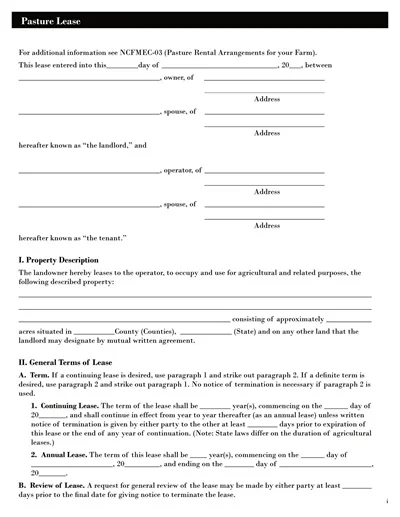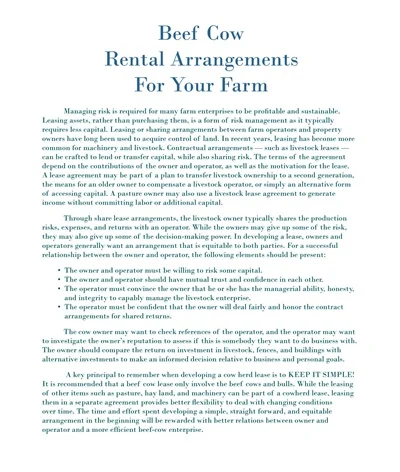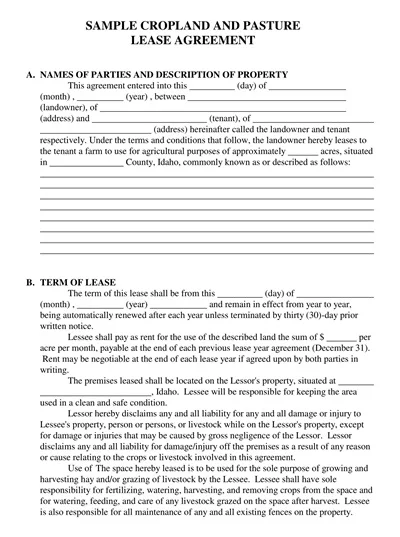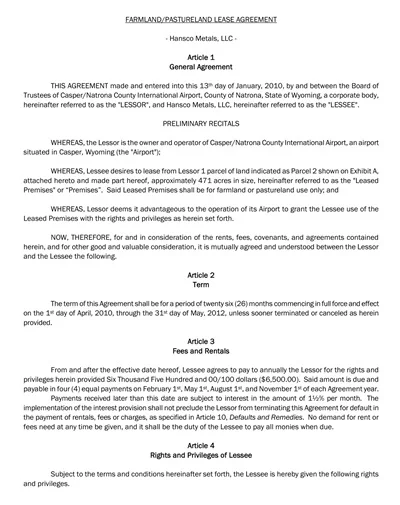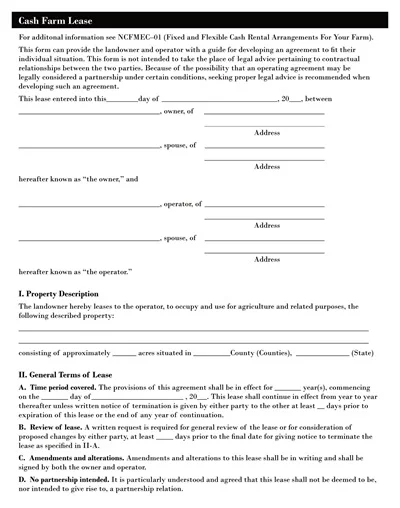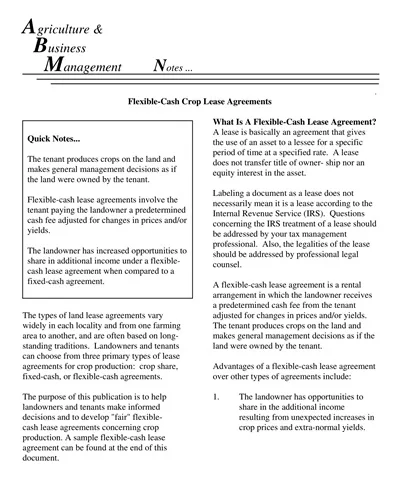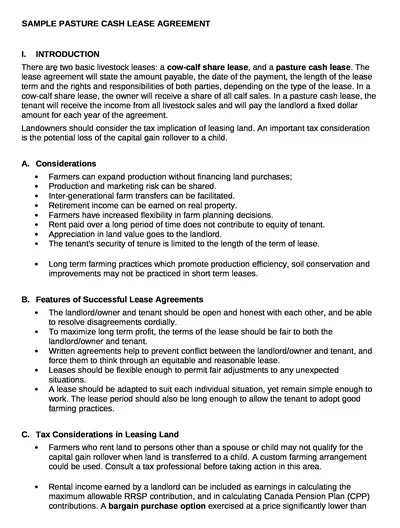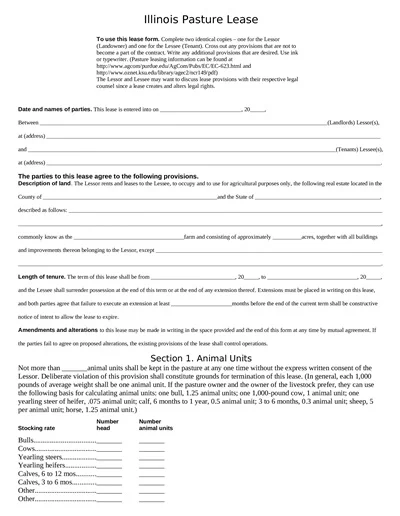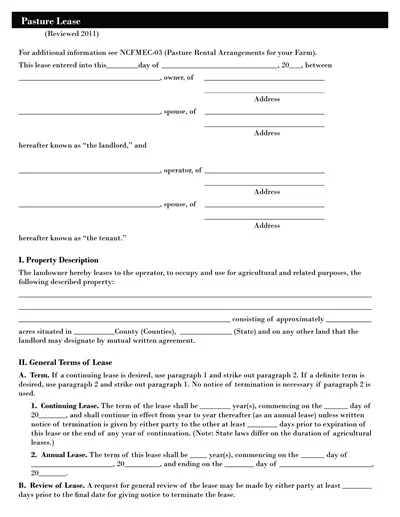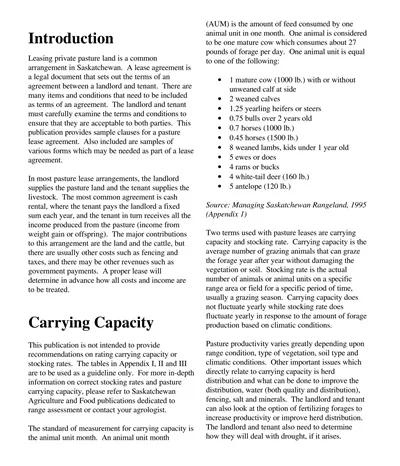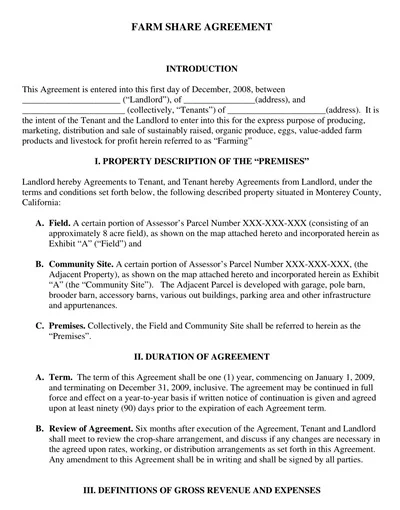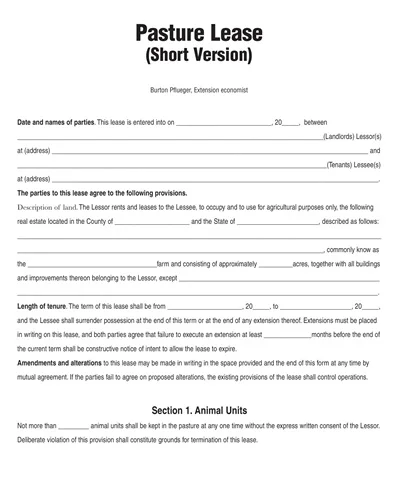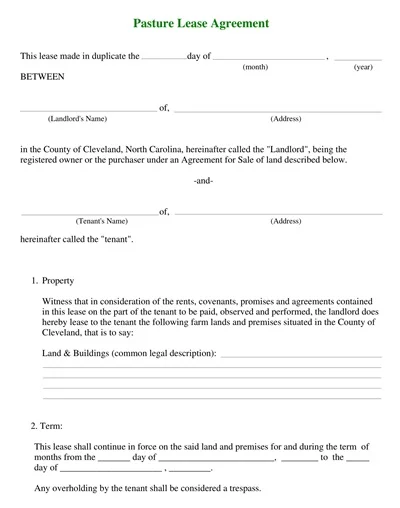30+ Free Simple Pasture Lease Agreement Templates – PDF, DOC
A Pasture Lease Agreement Template is an outline of the document with standard statements concerning the lease between a landowner and a tenant which gives the right to the livestock grazing of the tenant under the conditions of the lease on the land of the landowner. This template follows the course of the contract of lease which covers such things as the duration of the lease, the rent amount, responsibilities of both parties concerned, and any necessary repairs or improvements applied.
Commonly, the lease terms stipulate the land estate, lawful activities there, stocking limits, and terms for reinstating the lease or terminating it. One of the benefits is that both parties can employ a template, a tool that forces them to consider legally binding and functional issues bullet-pointing the feasibility and mutual benefits for the relationship.
Download Free Simple Pasture Lease Agreement Templates
What is a Pasture Lease Agreement?
A Pasture Lease Agreement is the name of a contractual deal between a person, who is a landowner, and another, who is the tenant, where the latter uses pasture land to graze his/her animals. This contract, which is of legal effect, states the lease terms as well as the aspects of property use, the duration of a lease, the payment plans, as well as the responsibilities of both tenants and lessors.
The contract deals with matters such as pasture upkeep, stock increase, and availability of water facilities. The legislature of such matters by a written contract may help the landowner and the lessee ensure that each of THEM understands exactly what is at issue and that any disputes that may arise are reduced.
What’s Included in a Pasture Lease Agreement Form?
A comprehensive Pasture Lease Agreement Form should include the following key elements:
- Parties Involved: Names and contact information of both the lessor owner of a property and the lessee person who will occupy.
- Property Description: An account of the land area to be leased which illustrates the extent of the area, its location, and any particular features of the land.
- Lease Term: the terms of the lease stipulate which dates would be effective and what date it ends.
- Rent Payment: Quantity of rent to be paid, payment schedule, if any, their related penalties.
- Use of Property: Approved Usage of the property will be based on the factors, including grazing livestock, the kind of livestock allowed, and any prohibited activities.
- Maintenance Responsibilities: I am responsible for taking care of the fences, water sources, as well as other utility structures.
- Improvements: Procedures concerning work on the land and things built, who is responsible for the costs.
- Insurance Requirements: The following are outlines of the insurance coverage needed for the landlord and lessee.
- Termination Clause: Discussion on conditions of lease where either party may terminate on an agreed notice.
- Dispute Resolution: Possible approaches to settle any sort of plights that might occur during rental contracts.
- Signatures: The final appendix will include the signatures of both parties as evidence of agreement that all the terms have been met.
To this end, the lease agreement pointed out which type of activities fell under the landlord’s and the tenant’s area of influence. As a result, there was no room for a conflict related to the land ordinances earlier on.
Uses of a Pasture Lease Agreement
A pasture lease agreement performs multiple tasks including providing a base for smooth operations and apparent understanding between the two parties.
Land Use Specifications
It is apparent that the accord categorically states the purposes which are permissible on the pasturelands including raising livestock or growing some crops and also avoids any inappropriate use of the property.
Duration of Lease
It sets the lease term, thus giving tenants and landlords an understanding of their commitments and enabling them to properly plan.
Payment Terms
The arrangement represents the rental amount, the schedule of payments, and any penalties related to the lateness, thereby making the deal clear-cut and serving as the financial record.
Maintenance Responsibilities
Details concerning the care and repair of fences, water supplies, and other infrastructures are provided, specifying who is responsible and therefore resolving conflicts of ownership.
Liability and Insurance
This law requires that the landowner and the tenant should have insurance policies meant for compensation in case of the occurrence of accidents or damages.
Termination Conditions
The lease can be terminated by either party in conditions specified in the Terms and Conditions section, creating an orderly exit structure and remedying violations of the agreement.
Subleasing Clauses
Concerns over subleasing the pasture to another person are addressed by including the rules for this, with the promise that the primary leaseholder will remain accountable.
Benefits of a Pasture Lease Agreement
A pasture lease agreement is an essential document that outlines the terms and conditions of renting or leasing a piece of land for grazing livestock. This type of agreement is beneficial for both the landowner and the tenant, as it clarifies their respective rights and responsibilities.
Here are some of the benefits of having a pasture lease agreement:
- Cost-Effective Grazing: A pasture lease agreement enables livestock owners to access grazing land without the high costs associated with purchasing property. This makes it an economical choice for managing herds.
- Flexibility: A pasture lease agreement is a very crucial document that highlights the terms and conditions governing the rental or lease of a parcel of land for grazing livestock. This agreement of the type is good for the landowner and the tenant for it confirms what rights and duties are due to each of them.
- Cost-Effective Grazing: Livestock owners can get access to the grazing land without paying the high land prices by signing a pasture lease agreement. Such reduces the cost of herd management.
- Flexibility: It allows easy relocation of the pasture depending on the need. This is particularly useful in times when the quality of pasture changes or different forage options are desired.
- Risk Management: Through leasing rather than owning land, livestock owners can decrease the economic risk that comes from crop failure, drought, or any natural events that would have affected the grass’s quality.
- Land Utilization: Pasture lease arrangements allow landowners to put their property to work, converting otherwise tracts of land to a financially useful asset through lease income.
- Reduced Maintenance: Leasing may help to relieve some of the maintenance responsibilities of livestock owners, including fencing repairs and weed control, if this is included in the lease agreement.
- Access to Larger Grazing Areas: Lease agreements can provide access to large or additional pastures that may sustain the increase of a livestock operation without having to make huge capital investments.
- Environmental Benefits: Carefully monitored range livestock leasing may improve land health by avoiding overgrazing, fostering biodiversity, and safeguarding soil health through rotational grazing. Leasing pasture provides the flexibility to change the location of grazing land as needed. This can be particularly beneficial if the quality of the pasture changes or if different forage options are desired.
- Risk Management: By leasing rather than owning land, livestock owners can reduce the financial risk associated with crop failure, drought, or other natural events that could affect pasture quality.
- Land Utilization: Pasture lease agreements help landowners utilize their property efficiently, turning otherwise unused land into a profitable resource through rental income.
- Reduced Maintenance: Leasing can alleviate some of the maintenance responsibilities for livestock owners, such as fencing repairs and weed control if these are covered by the lease terms.
- Access to Larger Grazing Areas: A lease agreement can provide access to larger or additional grazing areas, which can support the expansion of the livestock operation without the need for significant capital investment.
- Environmental Benefits: Well-managed grazing through lease agreements can improve land health by preventing overgrazing, promoting biodiversity, and protecting soil quality through rotational grazing practices.
Legal Considerations in a Pasture Lease Agreement
While dealing with the pasture lease agreement, there are some important legal considerations whose attention must be drawn to and released to achieve a fair and enforceable contract. In the first place, the lease agreement should point out exactly the term of use, specifying how the pasture is used (e. g. hourly or daily), the boundaries of the pasture, and what kind of livestock may be rented (e. g. horses only). Furthermore, list the duties of both the lessor and lessee by specifying: maintenance obligations, water rights, and improvement or repair cases that require to be done.
Discussing the rent structuring and resolution of the payment process is another important component. In the agreement, a renter would have to accept the amount of rent, the acceptable schedules for payment, and the methods of payment is also expedient to feature dispute resolution processes in the leasing contracts as well to deal with any conflicts that may be encountered during the lease.
Besides, a tenant discharge should state the renter’s liability and insurance inclusions. It is a must for both individuals to decide and set down who is going to take responsibility for any harm or losses and if there is sufficient insurance coverage in place. This can enable a corporation to transfer and insure potential issues that unexpected events might bring.
Finally, it is important to abide by local and safety laws on the streets. According to agriculture, environmental, or zoning laws, the contract must be written which will therefore prevent any legal problems. It can potentially save plenty of unsettling experiences when a legal aspect is involved by consulting with a legal professional to draft or review the lease to make sure that all legal requirements are met, as well as the interests of both parties are protected.
How to Create a Pasture Lease Agreement Template
Preparing a comprehensive pasture lease agreement template requires rigorous steps to be put in place so that a landlord and a renter can read and understand all of their rights and responsibilities.
1. Preliminary Research
Do not start the pasture lease agreement without doing some background research on the pasture lease legal regulations and best practices in your zone. This research should explore, for example, local agricultural extension services, legal resources, and existing documents.
2. Header and Title
At the beginning of your template, you can have a simple header and a main title. The starting line of the section should be “Pasture Lease Agreement – Date. “Moreover, places for both parties immediately followed are strongly recommended.
3. Identifying Details
It is evident ensure the landowner’s (lessor) name and the tenant’s (lessee) address are provided. In the heading Identification, there should be put the official business names and contacts.
4. Specifications of the Property
Include a comprehensive description of the rental property on the lease agreement. List the total area, location, and any special areas within the property particularly for pastures. The map and the diagram can be a key aid in this regard.
5. Lease Term
Sometimes agree on the lease term duration. This part must focus on defining the initial and the final dates of the lease which includes the dependent term. Another is to indicate any clause for expansion or prolongation of the lease.
6. Rent Payment
Specify the rent payment conditions, consideration of the amount of rent to be paid, when it should be paid, and in which format (cash, check, or online). g. , the minimum and maximum amounts (gross and net), and attitudes towards overdue payments. Provide information on payment penalties for late payments and acceptable payment methods.
7. Use of the Property
Specify how the stiff can be used by the tenant according to their preferences. That item may include the kinds of cattle, the amount of maintenance for the pasture and any standard procedures that may affect the property.
8. Maintenance and Improvements
Extract the responsibilities for maintenance and enhancements. This involves who will bear responsibilities for the budget for fencing, water supply, and weed control, and the nature of each person’s participation.
9. Termination Terms
Describe the grounds under which the lease can be broken mutual consent or any other termination conditions. It should comprise the notice periods stipulated and other particular conditions (both legally and morally acceptable) under which terminations may be warranted.
10. Liability and Insurance
Detail who is responsible for items and any insurance necessities. This part is often supplemented by an indemnity clause as well as a necessity document which sets how to obtain and maintain liability insurance.
11. Signatures
Designate capacities featuring the lessor’s and the lessee’s signatures and names as well as the date of signing. This will be instrumental in reassuring the two parties that the subject matter of their agreement is properly understood.

